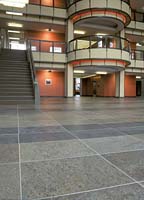

“We wanted the building's design to have an indoor/outdoor feeling,†said Henry Reeder AIA, partner-in-charge, of ARC Architecture Resources. “We used steel frame for the lobby to have an industrial feel - from the period that it originated from. For the flooring, slate was the perfect choice.â€
In choosing the right stone, durability and appropriateness were important factors. “We chose slate because we wanted a hard, long-lasting stone,†explained Reeder. “We wanted the material to be earthy - consistent with the building. The flooring had to fit the industrial purposes of the building.â€
In the 60-foot-high atrium, two different slates were used to complete the floor - Brazilian black slate and Brazilian multicolor slate, a brownish-reddish material. Both slates where laid out in bands and strips to create the desired pattern. The Brazilian black slate and Brazilian multicolor slate each consisted of 5,500 square feet, patterned in five sizes - 17 1â„4- x 24, 16 1â„8 x 24, 18 1â„2- x 24-, 16- x 24- and 24- x 24-inch tiles, according to supplier, Andy Salvey of Wallace and Salvey. Both slates were quarried in the Papagaios Region of Brazil by MAP Ltd. and given a natural, oil finish - not shiny, according to Reeder.
The Brazilian Black slate was also used in other parts of the building. In the bathrooms, 80 square feet of 12-inch tiles were installed. The Brazilian Multicolor slate was used in other sections as well - with 18- x 24-inch tiles were employed as borders in the elevator.
In terms of the challenges, the architect was faced with generating a design that flowed well. “The biggest challenge that the we encountered overall was getting the layout to complement the architecture,†said Reeder. Another challenge that occurred while working on the building was installation. “We were working with an existing concrete slab that was not level. It was tricky [leveling the floor to set the tile.]â€
“The flooring was installed with thin-set, over a cured mortar bed using Laticrete's thin-set additives,†explained James Fahey of Zani Tile Co, in Watertown, MA. “The month and a half process required three pairs of workers to complete the job.†The most difficult part of the installation was the floor preparation. “It was tough because the building was an old arsenal, therefore we had to work around the train tracks,†explained Fahey. To protect the stone, it was sealed with Miracle Sealants' 511 Porous Plus.

End box:
Watertown Arsenal
Watertown ArsenalBuilding 311
Watertown, MA
Architect: ARC Architecture Resources, Cambridge, MA
Stone Supplier: Wallace and Salvey, Waltham, MA
Quarrier: MAP Ltd., Papagaios, Brazil
Stone Installer: Zani Tile Co., Watertown, MA
Installation Products: Laticrete International, Bethany CT; Miracle Sealants Co., Arcadia, CA